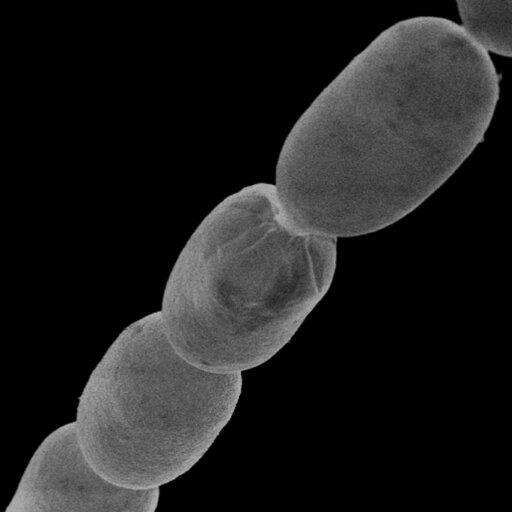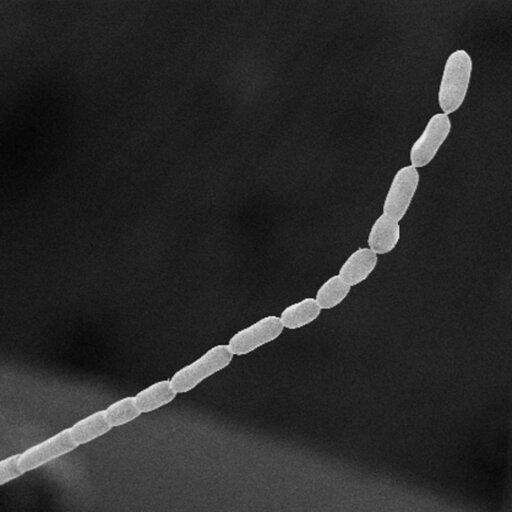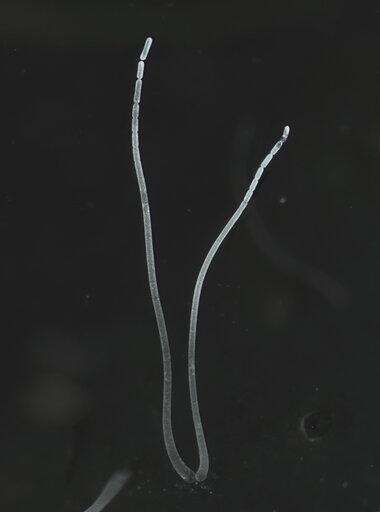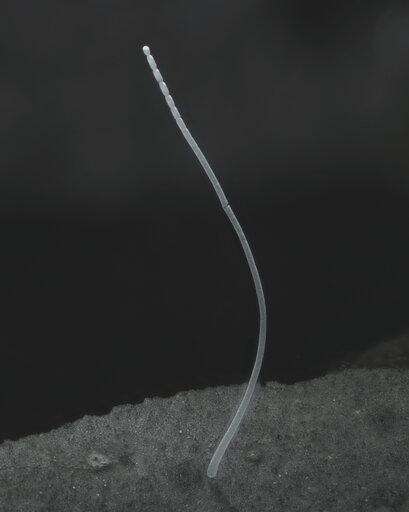This microscope photo provided by the Lawrence Berkeley National Laboratory in June 2022 shows thin strands of Thiomargarita magnifica bacteria cells next to a U.S. dime coin. The species was discovered among the mangroves of Guadeloupe archipelago in the French Caribbean. A team of researchers at the Department of Energy (DOE) Joint Genome Institute (JGI), Lawrence Berkeley National Laboratory (Berkeley Lab), the Laboratory for Research in Complex Systems (LRC), and the Université des Antilles, characterized the bacterium composed of a single cell that is 5,000 times larger than other bacteria. (Tomas Tyml/Lawrence Berkeley National Laboratory via AP)
The Associated Press
WASHINGTON (AP) - Scientists have discovered the world's largest bacterium in a Caribbean mangrove swamp.
Most bacteria are microscopic, but this one is so big it can be seen with the naked eye.
The thin white filament, approximately the size of a human eyelash, is 'œby far the largest bacterium known to date,'ť said Jean-Marie Volland, a marine biologist at the Lawrence Berkeley National Laboratory and co-author of a paper announcing the discovery Thursday in the journal Science.
Olivier Gros, a co-author and biologist at the University of the French West Indies and Guiana, found the first example of this bacterium - named Thiomargarita magnifica, or 'œmagnificent sulfur pearl'ť - clinging to sunken mangrove leaves in the archipelago of Guadeloupe in 2009.
But he didn't immediately know it was a bacterium because of its surprisingly large size -- these bacteria, on average, reach a length of a third of an inch (0.9 centimeters). Only later genetic analysis revealed the organism to be a single bacterial cell.
'œIt's an amazing discovery,'ť said Petra Levin, a microbiologist at Washington University in St Louis, who was not involved in the study. 'œIt opens up the question of how many of these giant bacteria are out there - and reminds us we should never, ever underestimate bacteria.'ť
Gros also found the bacterium attached to oyster shells, rocks and glass bottles in the swamp.
Scientists have not yet been able to grow it in lab culture, but the researchers' say the cell has a structure that's unusual for bacteria. One key difference: It has a large central compartment, or vacuole, that allows some cell functions to happen in that controlled environment instead of throughout the cell.
'œThe acquisition of this large central vacuole definitely helps a cell to bypass physical limitations ... on how big a cell can be,'ť said Manuel Campos, a biologist at the French National Center for Scientific Research, who was not involved in the study.
The researchers said they aren't certain why the bacterium is so large, but co-author Volland hypothesized it may be an adaptation to help it avoid being eaten by smaller organisms.
___
The Associated Press Health & Science Department receives support from the Howard Hughes Medical Institute's Department of Science Education. The AP is solely responsible for all content.
This photo provided by the Lawrence Berkeley National Laboratory in June 2022 shows mangroves in the Guadeloupe archipelago in the French Caribbean where the Thiomargarita magnifica bacteria were discovered. A team of researchers at the Department of Energy (DOE) Joint Genome Institute (JGI), Lawrence Berkeley National Laboratory (Berkeley Lab), the Laboratory for Research in Complex Systems (LRC), and the Université des Antilles, characterized the bacterium composed of a single cell that is 5,000 times larger than other bacteria. (Pierre Yves Pascal/Université des Antilles via AP)
The Associated Press

This microscope photo provided by the Lawrence Berkeley National Laboratory in June 2022 shows part of a Thiomargarita magnifica bacteria cell. The species was discovered among the mangroves of Guadeloupe archipelago in the French Caribbean. A team of researchers at the Department of Energy (DOE) Joint Genome Institute (JGI), Lawrence Berkeley National Laboratory (Berkeley Lab), the Laboratory for Research in Complex Systems (LRC), and the Université des Antilles, characterized the bacterium composed of a single cell that is 5,000 times larger than other bacteria. (Olivier Gros/Université des Antilles via AP)
The Associated Press

This microscope photo provided by the Lawrence Berkeley National Laboratory in June 2022 shows part of a Thiomargarita magnifica bacteria cell. The species was discovered among the mangroves of Guadeloupe archipelago in the French Caribbean. A team of researchers at the Department of Energy (DOE) Joint Genome Institute (JGI), Lawrence Berkeley National Laboratory (Berkeley Lab), the Laboratory for Research in Complex Systems (LRC), and the Université des Antilles, characterized the bacterium composed of a single cell that is 5,000 times larger than other bacteria. (Olivier Gros/Université des Antilles via AP)
The Associated Press

This microscope photo provided by the Lawrence Berkeley National Laboratory in June 2022 shows filaments of a Thiomargarita magnifica bacteria cell. The species was discovered among the mangroves of Guadeloupe archipelago in the French Caribbean. A team of researchers at the Department of Energy (DOE) Joint Genome Institute (JGI), Lawrence Berkeley National Laboratory (Berkeley Lab), the Laboratory for Research in Complex Systems (LRC), and the Université des Antilles, characterized the bacterium composed of a single cell that is 5,000 times larger than other bacteria. (Jean-Marie Volland/Lawrence Berkeley National Laboratory via AP)
The Associated Press

This microscope photo provided by the Lawrence Berkeley National Laboratory in June 2022 shows a filament of a Thiomargarita magnifica bacteria cell. The species was discovered among the mangroves of Guadeloupe archipelago in the French Caribbean. A team of researchers at the Department of Energy (DOE) Joint Genome Institute (JGI), Lawrence Berkeley National Laboratory (Berkeley Lab), the Laboratory for Research in Complex Systems (LRC), and the Université des Antilles, characterized the bacterium composed of a single cell that is 5,000 times larger than other bacteria. (Jean-Marie Volland/Lawrence Berkeley National Laboratory via AP)
The Associated Press

This photo provided by the Lawrence Berkeley National Laboratory in June 2022 shows mangroves in the Guadeloupe archipelago in the French Caribbean where the Thiomargarita magnifica bacteria was discovered. A team of researchers at the Department of Energy (DOE) Joint Genome Institute (JGI), Lawrence Berkeley National Laboratory (Berkeley Lab), the Laboratory for Research in Complex Systems (LRC), and the Université des Antilles, characterized the bacterium composed of a single cell that is 5,000 times larger than other bacteria. (Hugo Bret/Lawrence Berkeley National Laboratory via AP)
The Associated Press